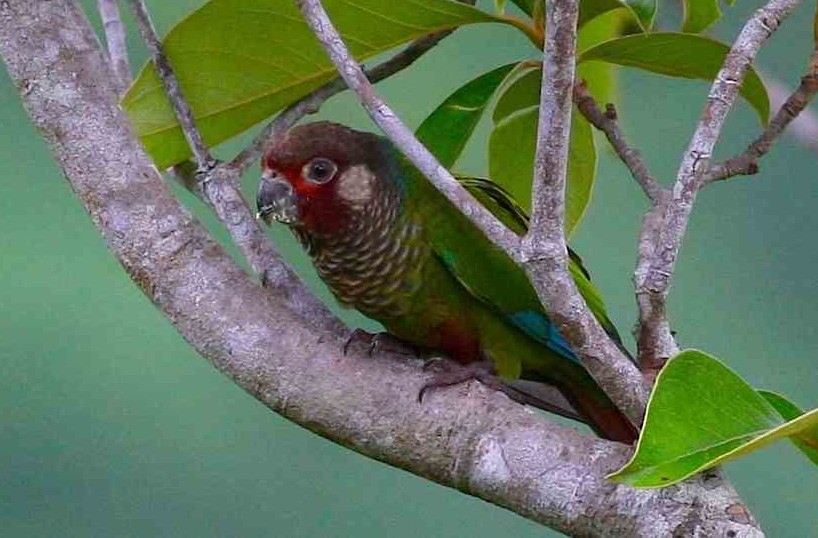Painted Parakeet
A species of Lesser Neotropical Parakeets Scientific name : Pyrrhura picta Genus : Lesser Neotropical Parakeets
Painted Parakeet, A species of Lesser Neotropical Parakeets
Botanical name: Pyrrhura picta
Genus: Lesser Neotropical Parakeets
Content
Description General Info
Description
The painted parakeet has a total length of approximately 22 cm (8 ⁄4 in). As other members of the genus Pyrrhura, it has a relatively long pointed tail and a mainly green plumage. The rump, central belly and tip to the tail are maroon-red, and the primary-coverts and outer webs of the primaries are blue. Except for subandina and some eisenmanni, adults of all subspecies have red to the leading edge of the wing, but this is often difficult to see (especially when perched). The feathers on the chest are dark with broad whitish-grey tips, resulting in a distinctly scaled effect. Depending on subspecies, the face and cheeks are dusky-maroon to maroon-red (sometimes with a bit of blue on the lowermost part), except in subandina where the cheeks are bluish-green. The ear-coverts are whitish to yellowish-buff. They have blue to the forecrown and nape, although the extent of this varies and blue to the foreground is typically barely visible in eisenmanni. The iris is generally reported and shown as being brown or dark, but at least eisenmanni and caeruleiceps can have light cream irides. 
Size
22 cm
Life Expectancy
13-15 years
Nest Placement
Cavity
Feeding Habits
Painted Parakeet thrives on a varied diet including fruits, flowers, nectar, and seeds. They forage in groups, showcasing unique adaptations like strong beaks to extract food. Preferences may involve certain fruits or feeding times, but this remains species-specific.
Habitat
The painted Parakeet inhabits a variety of forested habitats, predominantly in the mid to upper storeys of humid and wet forests, including primary terra firme, seasonally flooded várzea, and savanna forests. It is also found in forest margins, clearings with scattered trees, and hilly terrain at low elevations. Typically, these regions are characterized by hilly areas and dense canopies, where the painted Parakeet can occur from sea level up to 2200 meters in elevation. While primarily dependent on primary forests, the painted Parakeet adapts to partially cleared areas and forest-agricultural mosaics.
Dite type
Frugivorous
General Info
Feeding Habits
Bird food type

Fruit
Distribution Area
Traditionally, the painted parakeet included the Santarém parakeet (P. amazonum), Bonaparte's parakeet (P. lucianii) and rose-fronted parakeet (P. roseifrons) as subspecies. Following a review in 2002, it was recommended treating these as separate species. In 2006, a study based on mtDNA confirmed that the "traditional" painted parakeet was polyphyletic, as P. p. picta was closer to the taxon emma (traditionally considered a subspecies of the white-eared parakeet, P. leucotis) than it was to amazonum and roseifrons. The taxon lucianii was not sampled, but based on plumage and biogeography it likely falls between P. amazonum and P. roseifrons. In 2002 it had also been recommended treating the Azuero parakeet (P. eisenmanni), Sinú parakeet (P. subandina) and Todd's/Perijá parakeet (P. caeruleiceps) as separate species. Of these, only eisenmanni was sampled in 2006, where it, although with low bootstrap support, was found to be relatively close to P. p. picta, and arguably should be retained as a subspecies of the painted parakeet. Based on plumage and biogeography, caeruleiceps and subandina are likely also part of this group. Consequently, the South American Classification Committee voted for treating these as subspecies of the painted parakeet. The IOC has also split the Venezuelan parakeet from this species, but other authorities, including the American Ornithological Society have not followed. Following this treatment, the painted parakeet includes the following subspecies: P. p. picta (nominate): North-eastern Brazil (north of the Amazon River and east of the lower Rio Negro/Rio Branco, though crossing west of the latter in northern Roraima), the Guianas and south-eastern Venezuela. P. p. caeruleiceps (Todd's or Perijá parakeet): Perijá Mountains in Colombia and Venezuela, and the eastern slope of Magdalena Valley (= western slope of Cordillera Oriental) in Colombia. P. p. subandina (Sinú parakeet): Sinú Valley in Córdoba, Colombia. P. p. eisenmanni (Azuero parakeet): Azuero Peninsula, Panama. Nevertheless, the possibility that some of the above are separate biological species cannot be discounted at present. It has been suggested that auricularis should be considered a synonym of emma, but a recent review has suggested that auricularis is valid, and consequently it has tentatively been included here. Another taxon, pantchenkoi, has often been considered a valid subspecies or rarely even a separate species, but recent opinion is that it is a synonym of caeruleiceps. 
Species Status
Overall, this species remains widespread and relatively common, and consequently it is considered to be of least concern by BirdLife International and IUCN. The situation for the taxa in north-western South America (caeruleiceps and subandina) and Panama (eisenmanni) is more problematic, as all have restricted distributions within regions with extensive habitat destruction, and are also threatened by capture for the parrot trade. The taxon eisenmanni is believed to have a population of a less than 2000 individuals, but it remains locally relatively common, and a part of its range is within protected areas. Living individuals of the taxon caeruleiceps were only photographed for the first time in 2007, and the only relatively well-known population (in Norte de Santander) has been estimated to consist of at least 55 individuals. Little is known about the status of caeruleiceps elsewhere, but in 2011 two previously unknown populations, likely numbering less than 120 individuals in total, were discovered in the Cesar Department. Despite surveys specifically aimed at finding the taxon subandina, there are no recent records and it is possibly extinct. 
